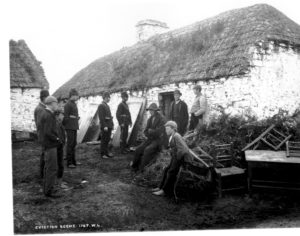
The Irish in America
Part I
See part 2 here.
St. Patrick’s Day is fast approaching; it is a day when many will wear something green, watch parades, eat corned beef and cabbage, and maybe hoist a green beer or two; for on this particular day as the saying goes, “Everyone wants to be Irish.” Today, there are 45 million Americans that can lay claim to some degree of Irish ancestry; their large numbers make Irish-Americans the second largest ethnic group (after German-Americans) in the country. And yet, they came to our shores from an island that is but half the size of New England. So what was it that brought all these sons and daughters of Erin to this country in the first place?
Not surprisingly, the ancestors of today’s Irish-Americans came here looking for land, economic advancement and religious freedom. Since the 1600s, more than seven million Irish have come to America. From the beginning, their influence changed American politics, religion, culture and economics. During the 1600s, it is estimated that between 50,000 and 100,000 Irish immigrated to the Colonies. During the 1700s and early 1800s, another half million sailed to this country in their wooden ships, and many of them entered America through the ports of New York and Boston. And from 1830 to 1914, almost 5 million Irish went to the United States alone. In 1890 two of every five Irish-born people were living abroad.
The major stimulus for this protracted exodus was the Great Hunger, also known as the Irish Potato Famine, which began in 1845 and lasted for over six years. By the early 1800s, Ireland was home to some eight million souls who were among the poorest people in the Western World. Only about a quarter of the Irish population could read or write. Life expectancy was short, averaging just 40 years for men. The Irish married quite young—girls at sixteen, boys at seventeen or eighteen—and they produced large families, although infant mortality was quite high.
At that time, half of all Irish families lived in single room, windowless mud cabins that had thatched roofs and didn’t have chimneys. The staple crop that sustained the Irish poor was the potato, which is rich in protein, carbohydrates, minerals and vitamins such as riboflavin, niacin and Vitamin C. It was therefore possible for the Irish to survive on a diet that consisted solely of potatoes. And because of their profound poverty, the Irish tenant farmers were forced to do just that, for it was their only means of staying alive.
But in 1845, and lasting for six years, a fungus named phytophthora infestans caused most of the potato crop to turn black and die in the fields. Soon, whole families began to starve and die: there were fathers too weak to care for their dying children, mothers dying with their dead babies in their frail arms, starving children weeping by dead parents. Those who managed to survive were often evicted from their homes by their landlords, because the failure of their crops made it impossible for them to pay the rent. And the method of eviction was exceedingly cruel: the family was taken from the home, while “house wreckers” came and took down the roof’s ridge pole, making the home uninhabitable. Often, the newly dispossessed were simply left to die of exposure in the cold Irish rains.
And meanwhile, records state that Ireland was exporting grain and cattle to England, in quantities which would have been sufficient to sustain those who were starving.
To be continued-